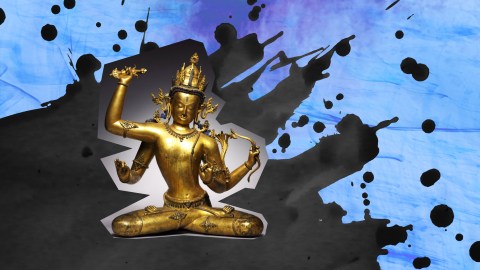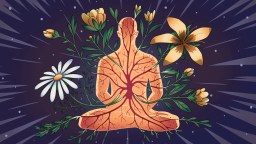In the West, yoga is exercise. In the East, it is something much bigger

- Yoga was refined and developed by the Rishis, wise men who documented their practices and beliefs in the Upanishads, a huge body of work believed to have been composed around 500 BC.
- Westerners who practice yoga generally do so without any spiritual component, but many Hindus would argue that this type of yoga is incomplete.
- Ultimately, yoga is about taming the mind and uniting with the divine.
While yoga has become a trendy lifestyle and wellness practice in North America, its roots are ancient, spiritual, and profound. Originally developed in Hinduism, yoga provides a path to achieve a higher state of consciousness and to unite with the divine.
The Sanskrit word yoga literally translates to “to yoke,” derived from the root word yiuj which means “to join,” “to integrate,” or “to harness.” The word yoga was first mentioned in one of the oldest texts known to humanity, the Rig Veda. The Rig Veda is the oldest of the Vedas — an ancient compendium of sacred songs, mantras, and rituals central to the Hindu religion. They are believed to have been composed between 1500 and 1200 BC.
The deity associated with yoga is Shiva, the Hindu god of destruction and regeneration. According to tradition, yogic knowledge was revealed as a divine gift by Shiva to the Rishis — sages or “men of vision” devoted to the spiritual life who, during their meditations, would receive visions or hear mantras and truths that others could not. In India, Rishis were given the highest reverence, and their words were more highly regarded than even the most royal leaders of society.
Yoga was refined and developed by the Rishis, and they documented their yoga practices and beliefs in the Upanishads, a huge body of work containing over 200 scriptures, believed to have been composed around 500 BC. Passed down by the Rishis through centuries by guru shishya parampara, the guru-disciple tradition, these teachings were given to people to help them realize their inherent divine nature.
The Bhagavad Gita is a revered Hindu text that is considered a part of the Mahabharata, an epic poem influenced by and based on the Vedas. Scholars date its composition between the 5th and 2nd centuries BC. Within the Bhagavad Gita, there are significant references to yogic practices and principles. It states that, “When the mind, restrained from material activities, becomes still by the practice of yoga, then the yogi is able to behold the soul through the purified mind, and he rejoices in the inner joy.”
The primary paths of yoga
There are four primary paths through which yoga is expressed: Karma yoga (yoga of action), Bhakti yoga (yoga of devotion), Jñāna yoga (yoga of knowledge), and Rāja yoga (yoga of mind control).
Karma yoga emphasizes selfless service and fulfilling one’s duties to sublimate the ego, purify the heart, and cultivate oneness. Physical activities like cooking, cleaning, and teaching are used. Bhakti yoga engages the emotional aspect of the mind through devotion to the divine, developing humility and surrender. Methods include praying, chanting, and participating in rituals. Jñāna yoga focuses on self-inquiry through intellectual questioning, reflection, and meditation on the nature of truth. Rāja yoga uses techniques like Hatha yoga (described below), cleansing, breathing exercises, and meditation to control the body, mind, and senses. Its emphasis on the physical body and the use of specific techniques to achieve particular outcomes are based on an understanding of the body’s physiology and the effects of the practices on the body and mind.
Hatha yoga: What Westerners call “yoga”
The Rishis understood that a weak body could not sit still for extended periods of time, so in order to prepare the body and mind for the practice of meditation (in pursuit of the path of Rāja yoga), the Rishis developed a preparatory practice called Hatha yoga. This is the type of yoga many North Americans practice as part of their physical fitness regimen.
The literal Sanskrit meaning of the word Hatha is “force” or “effort.” The popular Hindu interpretation of Hatha is that it refers to the uniting of the opposing sun (ha) and moon (tha) energies within the body, leading to balance and harmony. In this sense, Hatha yoga can be seen as a practice that uses physical force or effort to bring about a transformation in the body and mind, which is why the practice of Hatha yoga requires focus and concentration. Yoga master Swāmi Satchidānanda said, “Calming the mind is yoga. Not just standing on the head.”
When yoga was first introduced to the West by teachers like Swāmi Rama Tirtha and Paramhansa Yogānanda, they placed high emphasis on the spiritual aspects of the practice, teaching the complete system of yoga and its philosophy. But over time, Hatha yoga has become dominant without much spiritual education being passed on with it. The physical practice alone is incomplete. To practice yoga most effectively, an understanding of its philosophy is key. Yoga philosophy addresses the mind’s relationship to spiritual growth.
The spiritual connection between yoga and Hinduism
The late Jay Lakhani, Hindu author and tutor with Hindu Academy, described what happens during a yogic union:
“There’s something much more to us than meets the eye; we are more than material beings. Only through tremendous introspection can you rediscover essential identity. Not just the body, the mind, or the intellect, but the spirit that lights all of us up. And relinking ourselves with the spirit is the idea of yoga; joining up with our real nature.”
Essentially, yoga is a spiritual practice meant to help with purifying and preparing the body and mind to first recognize one’s atman (“soul”) within, and then unite it with Brahman or the divine. Hindu philosophy views this attainment of union with the divine as the ultimate goal of human existence, and it is called “Moksha” or “Mukti.” This attainment is said to be a liberation or release from the cycle of birth, death, and rebirth (samsara).
Atman is the Sanskrit word for “self” and “breath.” It refers to the Hindu concept of the soul — a universal self or eternal personality. Atman either transmigrates to a new life or attains release after death. Atman is part of the universal Brahman — the ultimate reality underlying all phenomena — and can commune or fuse with it. According to Hindu philosophy, the self or Atman is ultimately identical with the supreme reality of Brahman. Attaining Moksha means realizing this identity and becoming one with the divine. This state of oneness is characterized by a profound sense of peace, joy, and unity with all of creation.
The Vedas emphasized ritual sacrifice to please the gods, but the Rishis believed that true spiritual growth comes from internal sacrifice. This involves self-knowledge, recognizing that the true self is not the physical body or ego. Action involves performing selfless acts without attachment to results, and wisdom involves gaining understanding of reality through reflection and study. By sacrificing ego and desires through these means, the Rishis believed one could achieve spiritual growth and enlightenment, and unite with the divine.
Yoga can be a powerful tool for spiritual growth and enlightenment when practiced with intention and mindfulness, uniting the mind, body, and spirit. Like any spiritual journey, yoga is a deeply personal one. The individual style and its benefits may differ from person to person, but an understanding of the philosophy around this practice is key to reaping the intended benefits of this practice.
As it says in Bhagavad Gitā, Chapter 6, Verse 3:
“For one who has conquered the mind, the mind is the best of friends; but for one who has failed to do so, his mind will remain the greatest enemy. Yoga is the journey of the self, through the self, to the self.”





